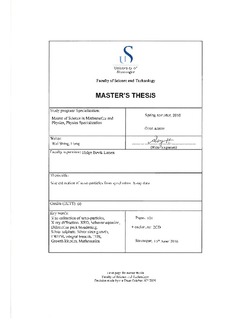| dc.contributor.author | Hung, Wai Shing | |
| dc.date.accessioned | 2016-09-12T08:22:20Z | |
| dc.date.available | 2016-09-12T08:22:20Z | |
| dc.date.issued | 2016-06-15 | |
| dc.identifier.uri | http://hdl.handle.net/11250/2406073 | |
| dc.description | Master's thesis in Mathematics and Physics | nb_NO |
| dc.description.abstract | Three samples of Ag2SO4 powder were heated up from 380 °C to 540 °C and then cooled down to 380 °C using an in-house made heat blower with a thermo-couple based temperature controller. During the heating process, synchrotron X-ray diffraction data including diffraction angles and intensitieswere obtained by diffractometer-setup found in the Swiss-Norwegian beamlines (SNBL- BM01A) at the ESRF. The diffractograms of each samples at different temperatures were studied byMathematica.
Ag2SO4 powder procured at “Sigma-Aldrich” did not showany diffraction peak in the diffractograms, but the Ag2SO4 powder obtained from crushing a large single crystal by pestle and mortar showed silver peaks in all five lowest reflections, 111, 200, 220, 311 and 222.
The sizes of the silver were estimated by Scherrer equation. The ways of defining peak Width and the choice of Scherrer constants were found to be vital for the accuracy of size estimations. Peak width was defined by two methods, namely FWHM and integral breadth. For FWHM method, the sizes of silver grew typically from around 50 (10) nm to 70 (10) nm when temperature increased from 380 °C to 432 °C. For integral breadth method, the sizes of silver grew typically fromaround 60 (10) nm to 80 (10) nm when temperature increased from 380 °C to 432 °C.
For both methods, silver crystallites were grown almost linearly with increasing temperature in all reflections within the temperature range of 380 °C to 432 °C. Then, silver crystallites stopped growing when temperature was over 432 °C that is close to the phase transition temperature of silver sulphate, 427 °C. It is very likely that the phase transition of silver sulphate prohibits the growth of metallic silver.
The main instrumental broadening was coming from the finite pixel size of the detector and the energy dispersion of the synchrotron radiation. The uncertainties in FWHM were 0.04° (0.01°) to 0.10° (0.01°). The magnitude of the instrumental broadening due to the energy dispersion of the synchrotron radiation was 10e-5° and was insignificant. | nb_NO |
| dc.language.iso | eng | nb_NO |
| dc.publisher | University of Stavanger, Norway | nb_NO |
| dc.relation.ispartofseries | Masteroppgave/UIS-TN-IMN/2016; | |
| dc.subject | mathematics | nb_NO |
| dc.subject | physics | nb_NO |
| dc.subject | size estimation of nano-particles | nb_NO |
| dc.subject | X-ray diffraction | nb_NO |
| dc.subject | XRD | nb_NO |
| dc.subject | scherrer equation | nb_NO |
| dc.subject | diffraction peak broadening | nb_NO |
| dc.subject | silver sulphate | nb_NO |
| dc.subject | silver sizes growth | nb_NO |
| dc.subject | FWHM | nb_NO |
| dc.subject | integral breadth | nb_NO |
| dc.subject | TDS | nb_NO |
| dc.subject | growth kinetics | nb_NO |
| dc.subject | mathematica | nb_NO |
| dc.subject | fysikk | nb_NO |
| dc.title | Size estimation of nano-particles from synchrotron X-ray data | nb_NO |
| dc.type | Master thesis | nb_NO |
| dc.subject.nsi | VDP::Mathematics and natural science: 400::Physics: 430 | nb_NO |
